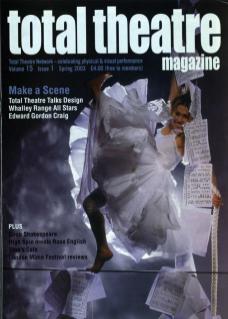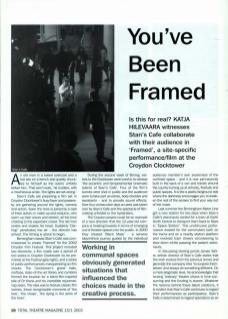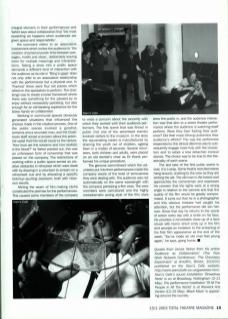An old man in a tweed overcoat and a hat sits on a bench and quietly chuckles to himself as the scene unfolds before him. ‘That won't work,' he mutters, with a mischievous smile, the lights are set wrong.
Stan's Cafe are preparing a film set in Croydon Clocktower's busy foyer and passersby are gathering around the lights, camera and action. Soon the crew is joined by a cast of three actors, in make-up and costume, who warm up their voices and stretch, all the time chatting to the expectant crowd. The old man smiles and shakes his head. Suddenly 'Darling!' penetrates the air – the director has arrived. The filming is about to begin.
Birmingham-based Stan's Cafe was commissioned to create Framed for the 2002 Croydon Film Festival. This project included two elements: a film made over a period of two weeks in Croydon Clocktower (to be premiered at the Festival gala night), and a series of public performances masquerading as film shoots. The Clocktower's grand halls, rooftops, state-of-the-art library and corridors formed the location for a silent-film-inspired tale of Dr Krank and his incredible rejuvenating cream. The idea was to feature classic film scenes, those recognisable moments of ‘the love', 'the chase', 'the dying in the arms of the lover'.
During the second week of filming, visitors to the Clocktower were lured in to witness ‘the eccentric and temperamental cinematic talents of Stan's Cafe'. Four of the film's scenes were shot in public and the audience were to take part as extras, body doubles and assistants – and to provide sound effects. Over four consecutive days an area was taken over by Stan's Cafe and the spectacle of film-making unfolded to the bystanders.
The Croydon project could be an example of a new direction that the twelve year-old company is heading towards in terms of emerging out of theatre spaces into the public. In 2000 they created Black Maze – a sensory labyrinthine journey guided by the individual audience member's own awareness of the confined space – and it is now permanently built in the back of a van and travels around the country turning up at schools, festivals and public spaces. It is like a poetic fairground ride where the darkness encourages you to awaken the rest of the senses to find your way out of the maze.
Last summer the Birmingham Metro Line got a new station for two days when Stan's Cafe's astronauts waited for a tram at Earth North Central to transport them back to Mars in 'Space Station'. This unobtrusive performance existed for the commuters both on the trams and on a nearby station platform and involved tram drivers volunteering to slow down whilst passing the patient astronauts.
In discussing starting points James Yarker, artistic director of Stan's Cafe, states that the work evolves from the previous shows and generally the company tries ‘to surprise themselves' and always do something different. On a more pragmatic level, he acknowledges that touring ‘ordinary' theatre shows is time-consuming and the funding is scarce. Whatever the reasons behind these latest creations, it is evident that Stan's Cafe continues to regard their performances as participatory. Stan's Cafe is determined to regard spectators as an integral element in their performances and Yarker says about collaboration that ‘the most rewarding art happens when audiences are given space and responsibility’.
His comment refers to an associative involvement which invites the audience to ‘the creation of personal poetic links between passages, motifs and ideas', deliberately leaving room for multiple meanings and interpretations. Taking a show into a public space demands a different kind of interaction with the audience as its role in 'filling in gaps' does not only refer to an associative relationship with the performance but a physical one. In Framed there were four set pieces which relied on the spectators to perform. The challenge was to create a loose framework where there was something for the passers-by to enjoy without necessarily partaking, but also enough for an exhilarating experience for the brave hands-on collaborator.
Working in communal spaces obviously generated situations that influenced the choices made in the creative process. One of the public scenes involved a gunshot, screams and a wounded man, and the Clocktower staff voiced a concern about the potential upset that this would cause to the visitors. ‘How loud are the screams and how realistic is the blood?' As Yarker pointed out, this was an unforeseen form of censorship that was placed on the company. The restrictions of working within a public space served as creative obstacles in rehearsal which were dealt with by drawing in a volunteer to scream on a rehearsed cue and by allocating a specific ketchup-spurting assistant: both with hilarious results.
Mining the seam of film-making cliché constituted the premise for the performances. This caused some members of the company to voice a concern about the sincerity with which they worked with their audience-performers. The first scene that was filmed in public (not one of the advertised events) involved visitors to the museum. In the story the rejuvenating cream is manufactured by draining the youth out of children, ageing them in a matter of seconds. Several volunteers, both children and adults, were placed on an old dentist's chair as Dr Krank performed his unique procedure.
The genuine commitment which the volunteers put into their performances made the company aware of the level of seriousness they were dealing with. The audience was not automatically on the same wavelength with the company parodying a film crew. The crew members were caricatured and the highly melodramatic acting style of the film stars drew the public in, and the audience interaction was that akin to a street theatre performance where the audience is watching itself perform. Were they then fooling their audience? Did their mock-filming undermine their audience's efforts? The way the performers responded to this ethical dilemma was to subsequently engage more fully with the characters and to adopt a less detached ironical stance. The choice was to be true to the theatricality of each scene.
The last take of the first public scene is over, it is a wrap. Some freshly recruited extras hang around, chatting to the crew as they are striking the set. The old man in the tweed coat approaches the cameraman and expresses his concern that the lights were at a wrong angle in relation to the camera and that the quality of the film would be greatly compromised. It turns out that he is a photographer and this obvious mistake had caught his attention, but the performance did win him over. Since that day he returns to the scene of action every day with a smile on his face. He provides a remarkable close-up of a face struck with horror which ends up in the film and accepts an invitation to the screening of his first film appearance at the end of the week. ‘You’ve made an old man feel young again,' he says, going home.
Quotes from James Yarker from his article ‘Audience as Collaborators' (The New Work Network Conference: 'The Chemistry Experiment' at Arnolfini, Bristol, 10/2/01) published on the Stan's Cafe website: http://www.stansCafe.co.uk/gazetteer.html.
Stan's Cafe's sound installation Broadway Hertz is on at Broadway, Nottingham (2-11 May). The performance installation of All The People In All The World is at Warwick Arts Centre (12-15 May). Black Maze is appearing around the country.


